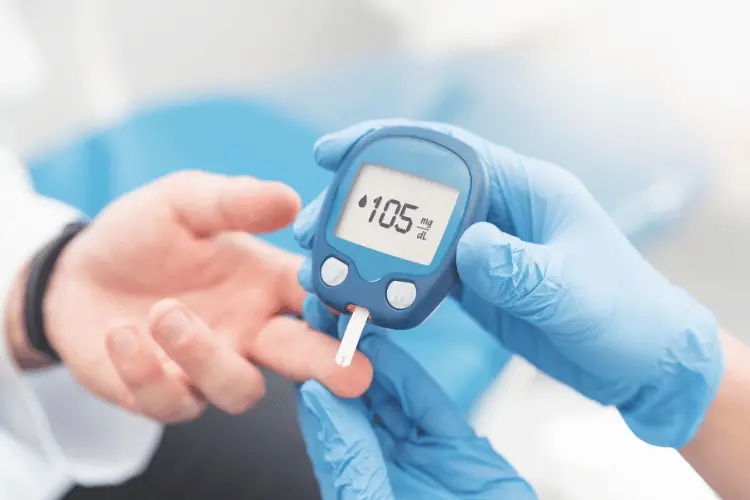Insulin plays a major role in the production and management of energy and blood sugar. It’s a crucial component for the transportation of glucose to cells and tissues, such as the skeletal muscles, heart, and liver. The body won’t survive long without it.
Insulin resistance—a condition in which the body doesn’t respond well to insulin—is incredibly common in American society. Despite that, it’s still widely misunderstood. If people understood it, we wouldn’t have an obesity epidemic.
I also find myself constantly teaching my clients about insulin and how it relates to exercise.
To shed some light on this condition, I’ve gathered a list of some of the most interesting facts about insulin and exercise. We’ll cover how insulin is produced, how exercise affects insulin levels, how high insulin levels prevent weight loss, and more.
Fact #1: Insulin Is Produced By Your Pancreas
Insulin is a naturally occurring hormone produced by a group of cells in your pancreas. It helps your body convert food into energy or store it for future use.
Insulin is an essential hormone. It’s often described as the “key” that opens the doors to the glucose (blood sugar) in your body. Without it, glucose can’t get into your cells. It would remain in your blood, causing your blood glucose levels to increase to dangerous levels.
Eating large amounts of sugar causes your body to make large amounts of insulin. The excessive production of insulin can lead to major, life-threatening complications like diabetic ketoacidosis (buildup of acids in the blood) and hyperglycemia (buildup of sugar in the blood).
Insulin deficiency occurs when the pancreas doesn’t work as it should. The pancreas may not make or release the insulin the body needs to control blood sugar levels, resulting in diabetes.
Fact #2: In the US, More Than 80 Million People Are Insulin Resistant
Insulin resistance, otherwise known as impaired insulin sensitivity, is a pathological condition wherein the cells in the liver, muscles, and body fat don’t respond to the communication signs from insulin.
To make up for the lack of communication, the pancreas makes more insulin in hopes that the cells would respond. The overproduction of insulin causes blood sugar levels to go up, resulting in a myriad of health issues like high blood pressure, obesity, high cholesterol, and type 2 diabetes.
Insulin resistance is a serious—and sometimes deadly—condition. It doubles a person’s risk for heart attack and stroke and triples the odds that they’ll be deadly. It’s also linked with a higher risk for cancers of the breast, pancreas, bladder, colon, uterus, and prostate.
According to the National Institutes of Health, more than 84 million Americans are insulin resistant. That’s about 1 out of every 3 adults. Most of those affected are 45 and older, but it can develop in children as young as five.
The main contributing factors for insulin resistance include:
- Excess body fat, especially around your belly and waist
- Lack of physical activity
- Diet of highly processed, saturated fats, and high-carbohydrate foods
- Family history of type 2 diabetes
- Long-term use of certain medications, like blood pressure medications, steroids, psychiatric medications, and HIV treatments
- Hormonal disorders like Cushing’s syndrome (excess cortisol in the body), acromegaly (high levels of growth hormone), and hypothyroidism (lack of thyroid hormone in the bloodstream)
Fact #3: Diabetes Comes In Three Types
Diabetes comes in three types: type 1, type 2, and gestational (occurring during pregnancy). Among all three types, the most common is type 2 diabetes. Approximately 90 to 95% of diabetics suffer from type 2, while about 5% suffer from type 1. The rest have gestational diabetes.
-Type 1 Diabetes
Type 1 diabetes is a genetic condition. Unlike type 2 diabetes, it isn’t caused by diet and lifestyle and often shows up early in life.
It’s caused by an autoimmune reaction that attacks and destroys the insulin-producing beta cells in the pancreas, preventing the body from producing insulin.
Scientists have yet to understand why the immune system of type 1 diabetics attacks the body’s cells. Most believe that this is something to do with genetic and environmental factors, like exposure to certain viruses.
People with type 1 diabetes need to take insulin every day to survive.
-Type 2 Diabetes
Unlike type 1 diabetes, type 2 diabetes is developmental. It’s often caused by lifestyle factors, like excessive body weight and inactivity.
People with type 2 diabetes can produce insulin, but they either produce too little or too much. It’s most common with people over the age of 45, but children as young as five can be affected as well.
-Gestational Diabetes
The third and less talked about type of diabetes is gestational diabetes.
As the name suggests, gestational diabetes only occurs in pregnant women. It appears when the body can’t make enough insulin during pregnancy. It can happen at any stage, but it’s most common during the second or third trimesters.
Though it disappears after the baby is born, gestational diabetes can cause problems for both the mom and the baby after birth. Risks can be reduced if the condition is well-managed and detected early.
Fact #4: Diabetes Is One of the World’s Leading Causes of Death
According to the online scientific publication Our World in Data, diabetes is the 8th leading cause of death across the globe. The full list is as follows:

- Cardiovascular diseases
- Cancers
- Respiratory diseases
- Digestive diseases
- Lower respiratory infections
- Neonatal disorders
- Dementia
- Diabetes
- Diarrheal diseases
- Liver diseases
Diabetes results in the death of more than 1.5 million people in the world.
By 2030, the World Health Organization (WHO) predicts that the disease will jump from the eighth-leading cause to the seventh-leading cause of mortality worldwide.
Low and middle-income countries encompass more than 80% of deaths related to diabetes. Nearly 50% of these deaths occurred before the age of 70.
Fact #5: Insufficient or Excessive Blood Sugar Can Result In a Diabetic Coma
You read that right; diabetes can cause a diabetic person to fall into a coma. As if the disease wasn’t frightening enough, with all the life-threatening symptoms associated with it!
For the uninitiated, a diabetic coma is a medical emergency wherein the person affected falls unconscious due to dangerously low blood sugar (hypoglycemia) or dangerously high blood sugar (hyperglycemia).
With immediate treatment, patients who fall into a diabetic coma can make a full recovery. But without early treatment, the coma can result in brain damage and, in worse cases, death.
Here are the common symptoms associated with uncontrolled blood sugar before a diabetic coma:
- Difficulty breathing
- Dizziness
- Weakness
- Confusion
- Vomiting and nausea
- Increased thirst
- Frequent urination
- Blurred vision
- Stomach pain
If you or a loved one experiences symptoms of extremely low or high blood sugar, contact 911 or your local emergency number to make sure help arrives in time.
If you have no training in diabetes care, follow the emergency team’s instructions and wait for help to arrive.
For those familiar with diabetes care, test the unconscious person’s blood sugar. If it’s lower than 70 mg/dL (3.9 mmol/L), give the person an injection of glucagon. Don’t attempt to give the affected person any fluids or insulin. If it’s above 70 mg/dL, wait for medical help.
Fact #6: Insulin Coma Was Used as a “Cure” for Schizophrenia and Other Mental Illnesses
Between the 1930s and the 1960s, deep insulin coma therapy (DICT) was the frontline treatment for schizophrenia and other mental illnesses, such as paranoia, obsessive and compulsive thinking, hallucinations, and anxiety. It was thought to relieve symptoms of fear, hostility, and delusions by “jolting” the patient out of an episode of mental illness.
Much like electroshock therapy, insulin coma therapy was as ineffective as it was deadly. The therapy took place over a number of weeks or months, with patients receiving an unhealthy dose of insulin to forcefully induce a coma-like state then reversed with a shot of glucose after an hour. The insulin dosage was increased daily until the doctor deemed the patient to be at “maximum benefit,” which was between 30 to 50 comas.
Unsurprisingly, these commas left unwanted and often deadly side effects like brain damage, obesity, and irreversible or prolonged coma. Around 1 to 2% of the patients died during or after the procedure, with the vast majority experiencing varying degrees of permanent brain damage.
Insulin coma therapy was abandoned in the 1960s with the introduction of new psychotropic drugs and banned completely in the 1970s. To date, there’s no known treatment for schizophrenia.
Fact #7: Physical Activity Can Lower Insulin Levels
According to the American Diabetes Association (ADA), exercise can lower your blood sugar for 24 hours or more by increasing the body’s insulin sensitivity. High insulin sensitivity helps pancreatic cells use blood glucose more effectively, thereby reducing blood sugar and decreasing triglyceride and LDL (“bad”) cholesterol levels.
This means that physical activity not only helps control blood sugar levels but also lowers your risk of nerve damage, heart disease, and obesity.
Additional benefits of regular physical activity for diabetes (and pre-diabetics) include:
- Better sleep
- Improved memory
- Reduced risk of cardiovascular issues
- Weight loss
- Increased strength
- Improved well-being
Those with type 2 diabetes should strive to exercise regularly to enhance insulin action. Children and adolescents with type 2 diabetes should perform both resistance and aerobic exercise training for optimal outcomes.
Youth and adults with type 1 diabetes also benefit from regular physical activity, but insulin reductions and/or additional carbohydrate intake may be required to maintain an optional glycemic balance during and after physical activity.
Fact #8: Hyperinsulinemia and Diabetes Are Two Separate Conditions
Hyperinsulinemia is a condition in which the insulin levels in the blood are higher than normal. Because of this, hyperinsulinemia is often associated with type 2 diabetes. However, hyperinsulinemia is two different conditions with varying symptoms.

Diabetes is a condition that occurs when the pancreas is no longer able to make insulin, whereas hyperinsulinemia occurs when a person has excess insulin in their blood due to pancreatic issues.
Hyperinsulinemia is often a result of insulin resistance, a condition that prevents the body’s cells from using insulin effectively. The resistance leads to higher levels of blood glucose, which is the triggering factor of hyperinsulinemia.
Hyperinsulinemia and insulin resistance rarely exist outside each other. Those that suffer from both conditions may experience chronic high blood sugar (hyperglycemia), which can lead to prediabetes and Type 2 diabetes.
In addition to the latter two conditions, hyperinsulinemia is also associated with:
- Polycystic ovary syndrome (PCOS)
- High triglyceride levels
- High blood pressure
- High uric acid
- Metabolic syndrome
- Obesity
- Atherosclerosis (hardening of the arteries)
Hyperinsulinemia can be treated with dietary changes and lifestyle modifications, with the most effective being exercise. Exercise has the ability to lower insulin levels and increase insulin sensitivity, which can reverse and treat hyperinsulinemia.
Fact #9: High Insulin Levels Can Prevent Weight Loss
High levels of insulin block the body’s ability to burn fat.
Under normal circumstances, the pancreas releases insulin after a meal and converts glucose into energy. The liver stores excess glucose to use as energy later when your body needs to produce energy during an exercise, or when you’re sleeping or not eating.
But if you have insulin resistance, your cells don’t properly respond to insulin. This can lead to increased glucose and insulin levels in the blood, which encourages the liver to store and accumulate extra fat.
What happens after is a snowball effect: the liver becomes less sensitive to insulin, pumping additional glucose into the blood when it shouldn’t. This then triggers the pancreas to create more insulin to bring the glucose levels back down. The liver takes the glucose and stores it as fat, and the cycle starts all over again.
If you’re experiencing minimal to no weight loss despite months of exercise and healthy eating, you might be suffering from high insulin levels. This isn’t to say that you can’t lose weight with high insulin levels; you can, as long as you balance your blood glucose levels.
Here’s the good news: insulin resistance—and subsequently, high insulin levels—are reversible with lifestyle changes and proper medication.
Fact #10: Aerobic Exercise Increases Glucose Uptake by as Much as Fifty Times
Aerobic exercises are exercises that involve continuous, repeated movements of major muscle groups. The term “aerobic” quite literally means “with oxygen,” referring to the increased use of oxygen to meet energy demands.
Aerobic exercise is any exercise that causes your heart to beat faster and lungs to pump harder. Examples of such activities include jogging, cycling, swimming, walking, hiking, and dancing.
According to a study published in the American Physiological Society, aerobic exercise can increase glucose uptake by 30 to 50 times. To balance out the blood glucose levels, insulin levels decrease and counter-regulatory hormones, such as growth hormones, cortisol, glucagon, and norepinephrine, increase.
This effect proves that aerobic exercises are among the best ways to manage and reduce blood sugar levels. However, aerobic exercises must be paired with a healthy diet to prevent cases of hypoglycemia (a too-low level of blood glucose). A healthy amount of carbohydrates must be consumed before and/or after exercise, and insulin doses must be reduced as per the doctor’s instructions.
Fact #11: Insulin Comes In Five Forms
As with most medications, insulin comes in varying forms: short-acting, intermediate-acting, rapid-acting, intermediate-acting, long-acting, and mixed. They’re categorized according to the onset (how quickly they act), peak (how long it takes to achieve the maximum effect), duration (how long it lasts until they wear off), and concentration (in units per ml).
Short-acting insulin takes a while to work. It lowers blood glucose levels within 30 minutes of application, so you’ll have to take the injection 30 minutes before a meal. It has an effect of two to five hours after injection and lasts approximately six to eight hours.
Intermediate-acting insulin works 60 to 90 minutes after injection. It’s absorbed more slowly and lasts longer than short-acting insulin, peaking between four to 12 hours and lasting between 16 to 24 hours. It’s used to control blood sugar while fasting, between meals, and while sleeping.
Fast-acting insulin is absorbed quickly into the bloodstream. It has an onset of five to 15 minutes, a peak effect in one to two hours, and a duration of four to six hours depending on the dose. This type of insulin acts quicker after a meal as it imitates the body’s natural insulin production, thereby reducing the risk of low blood glucose.
Long-acting insulin is absorbed slowly and has no apparent peak action. A single injection can last up to 24 hours.
Mixed insulin is a combination of 50 to 75% intermediate-acting insulin and 25 to 50% rapid- or short-acting insulin. It’s injected once, twice, or thrice a day, depending on the case’s severity.
Fact #12: Insulin Deficiency Can Hinder Muscle Production

Insulin aids the protein in amino acids to enter cells. Without enough insulin, protein metabolism is hindered, making it difficult to develop muscle mass. Moreover, insulin deficiency negatively affects the development of electrolytes like magnesium, potassium, and phosphate. These minerals are vital to muscle function, blood acidity, and water production.
The mechanisms by which insulin enhances muscle protein are still up for debate. However, various studies show a clear relationship between insulin and muscle mass. Insulin deficiency leads to a protein catabolic state with loss of muscle mass that can only be reversed by insulin therapy.
Fact #13: Exercise Lowers the Risk of Diabetes and Insulin-Related Conditions by Nearly 60%
Clinical trials show that half an hour of low-intensity exercise every day reduces the risk of developing type 2 diabetes by nearly 60%, especially when paired with a low-fat diet. Experts recommend the following healthcare regimen to further prevent the development of the disease:
- Perform at least 30 minutes of low to intermediate-intensity exercise a day
- Indulge in a low-sugar, low-fat diet that’s rich in fruits, vegetables, and whole grains
- Check your cholesterol levels at least once a year so you can take immediate steps to lower them if they cross the normal threshold. Your blood cholesterol should be below 200, with an HDL (good cholesterol) of over 60, an LDL (bad cholesterol) of under 100, and triglycerides (waxy fats) below 150.
- Avoid smoking or inhaling smoke as much as possible.
- Avoid drinking. If you must, drink in moderation.
- Maintain a “healthy” weight through well-balanced meals and exercise. Visit your doctor to provide you a healthy weight range depending on your height, sex, and age.
Fact #14: Hypoglycemia Is a Common Side Effect of Diabetes Medications
Hypoglycemia (low blood sugar) is a common side effect of certain diabetes medications, particularly those under the meglitinides and sulfonylureas class. Diabetes medication helps manage blood sugar by producing more or less insulin in the body.
But these medications can provide undesirable results if you eat significantly less than usual, drink too much alcohol without enough food, or increase your physical activity without the OK from your doctor. Instead of balancing your insulin levels, they can cause your blood sugar to significantly drop, resulting in hypoglycemia.
The best way to avoid diabetes-related hypoglycemia is to stick with your diet and exercise regimen. Check your blood sugar levels regularly to ensure your medication isn’t negatively affecting your glucose levels.
Other potential causes of hypoglycemia include:
- Binge drinking
- Pancreatic tumors
- Illnesses involving the heart, liver, or kidneys
- Low levels of hormones like glucagon, cortisol, and epinephrine
- Interactions with medications like sulfa antibiotics, quinine, aspirin, and pentamidine
- Impaired digestion caused by enzyme deficiencies or stomach surgery
Fact #15: Up to 80% Of People With Type 2 Diabetes Have NAFLD
It’s shocking, but true: a staggering 80% of type 2 diabetics suffer from Non-Alcoholic Fatty Liver Disease (NAFLD).
NAFLD is a term that describes a range of conditions caused by a build-up of harmful fat in the liver. It’s more prominent in overweight or obese patients, but it can also affect normal-weight individuals (termed as lean/non-obese NAFLD). Non-obese NAFLD occurs in less than 20% of patients.
Early-stage NAFLD isn’t deadly but can lead to serious liver damage if left untreated.
Final Thoughts
There you have it; some of the most interesting facts about insulin and its relationship with exercise! Insulin is a hormone produced by the pancreas. It’s responsible for converting food into energy and storing excess glucose for future use. People with insulin resistance struggle to convert food into energy, resulting in excessive sugar in the blood. Lack of physical activity and excess weight are the primary causes of insulin resistance.


